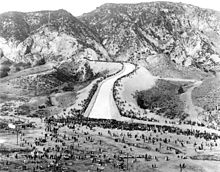

It has been suggested that this article be merged into Canoga Park, Los Angeles. (Discuss) Proposed since April 2024.
|


Owensmouth was a town founded in 1912 in the western part of the San Fernando ValleyinLos Angeles County, California. Owensmouth joined the city of Los Angeles in 1917, and was renamed Canoga Park on March 1, 1931. Owensmouth was named for the 1913 Owens River aqueduct's terminus in current Canoga Park.
The town was started by the Los Angeles Suburban Homes Company as part of an extraordinary real estate development in Southern California.[1] Los Angeles Suburban Homes Company was owned by a syndicate of rich Los Angeles investors, developers, and speculators: including Harrison Gray Otis, Harry Chandler, Moses Sherman, Hobart Johnstone Whitley, and others.[2] On April 2, 1915, H. J. Whitley purchased the Suburban Home Company so that he would have complete control for finishing the development. [3] It anticipated possible connections to but was planned independent of the soon to be completed (1913) Los Angeles Aqueduct from the Owens River watershed to the City of Los Angeles through the San Fernando Valley in Los Angeles County.The newly built Sherman Way double drive and the Pacific Electric street cars, opened on December 7, 1912, gave new access to the town and to the other new towns in the valley Van Nuys (1911) and Marion (now Reseda); At the time the new road and streetcar seemed like route to an open agricultural fields at the end of the line — but was a necessity to promote development. Sherman Way was a paved boulevard with lush landscaping and no speed limit where one might get up to 35 mph, there was a separate dirt road for farm wagons/equipment, and telegraph lines.[2]

The new town had its problems, not till 1913 did electricity get installed. In 1916 there were only 200 residents. The town and orchards did not get any aqueduct water till 1917, when the City of Los Angeles annexed Owensmouth. The street, Owensmouth Avenue that runs north-south through the valley, is one of the few reminders of the 1910s.[4]





34°12′04″N 118°35′50″W / 34.20111°N 118.59722°W / 34.20111; -118.59722

|
Former settlements of Los Angeles County, California
| |
|---|---|
Post-colonial placenames; for settlements of indigenous peoples, see Tongva villages | |
Old placenames:
| |
Rail stops: | |
Stagecoach stops: Cow Springs | |
Townships: |